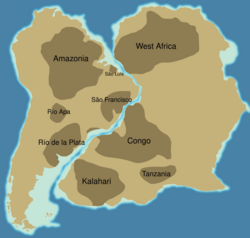Earth:São Francisco Craton

The São Francisco Craton is an ancient craton in the eastern part of South America. The craton crops out in the Brazil ian states of Minas Gerais and Bahia.
It includes a number of blocks of Archean basement, separated by orogenic belts. The belts are characterized by sedimentary basins and passive continental margins containing granite intrusions. The Paleoproterozoic (about 2.5 to 2.0 Ga) was the source of orogenic belts and the current configuration of the craton.
The São Francisco Craton around 1.0 Ga ago was in the south of the supercontinent Rodinia, and after the fragmentation of Rodinia in the late Proterozoic (700 Ma) became a member of the supercontinent Gondwana until it fragmented in the Jurassic (about 180 Ma). The subsequent opening of the Atlantic Ocean left Southern Africa in the Congo Craton and the São Francisco block in South America.
The ancient Paleoproterozoic orogenic belts of the São Francisco Craton contain many economically important minerals, particularly those containing iron (as in the Iron Quadrangle) and gold, and are a major source of income for the mining industry in Brazil.
See also
- Geography of Brazil
- Geography of South America
- South American Plate
- Río de la Plata Craton
References
Further reading
- Fernando F. Alkmim; Stephen Marshak; Marco A. Fonseca (April 2001). "Assembling West Gondwana in the Neoproterozoic: Clues from the São Francisco craton region, Brazil". Geology 29 (4): 319–322. doi:10.1130/0091-7613(2001)029<0319:AWGITN>2.0.CO;2. Bibcode: 2001Geo....29..319A.
- Pankhurst, Robert J. (2008). West Gondwana: Pre-Cenozoic Correlations Across the South Atlantic Region. Geological Society Special Publication. 294. London. pp. 432. ISBN 978-1-86239-247-2.
- Luiz R. Bastos Leal; José C. Cunha; Umberto G. Cordani et al. (January 2003). "SHRIMP U–Pb, 207Pb/206Pb zircon dating, and Nd isotopic signature of the Umburanas greenstone belt, northern São Francisco craton, Brazil". Journal of South American Earth Sciences 15 (7): 775–785. doi:10.1016/S0895-9811(02)00129-3. Bibcode: 2003JSAES..15..775B. http://www.cultura.ufpa.br/paraiso/publicacoes/leal2003.pdf.
- Zandt, George (Spring 2002). "Orogenic Systems: The Andes". University of Arizona. http://www.geo.arizona.edu/geo5xx/geo527/Andes/tectonicandes.html.
 |

